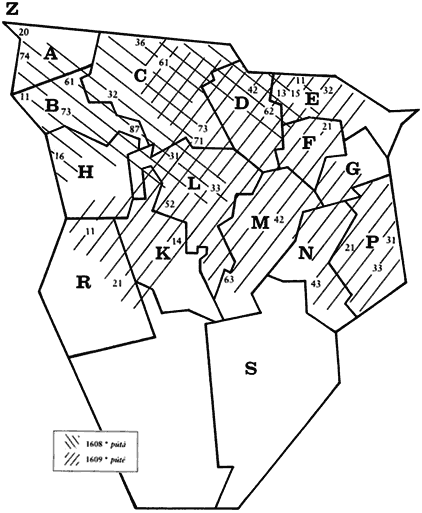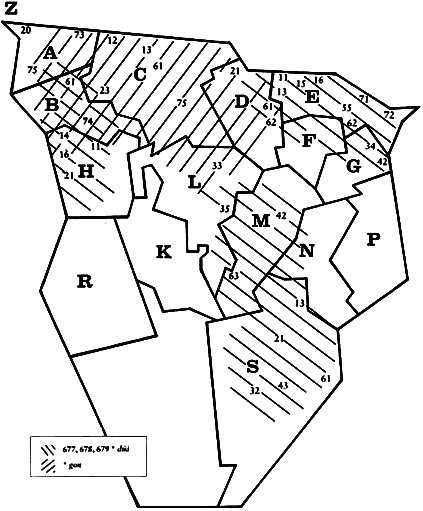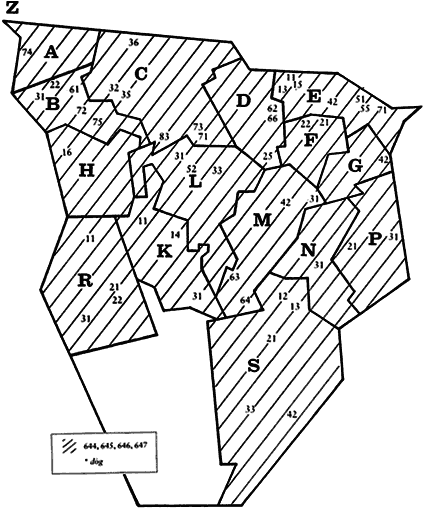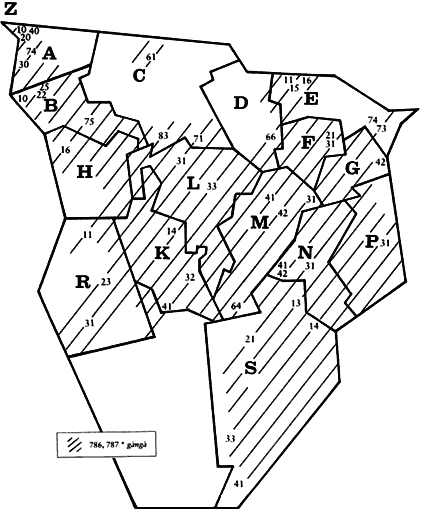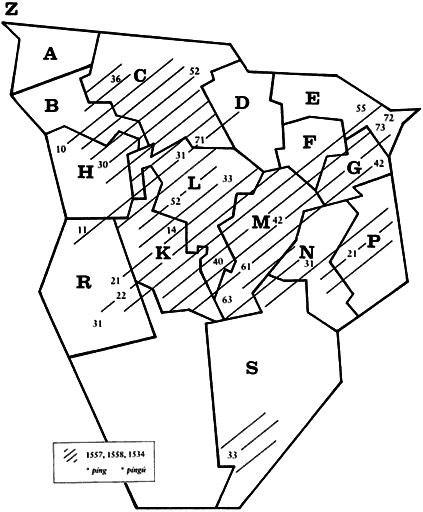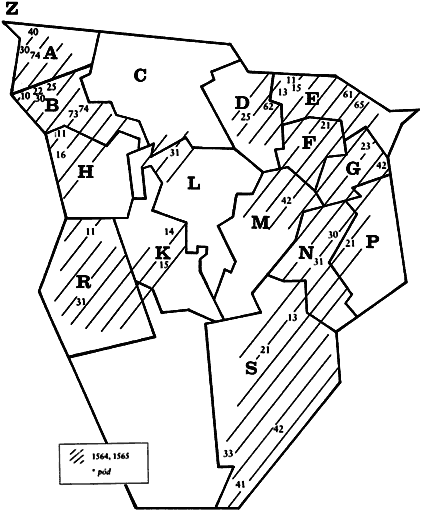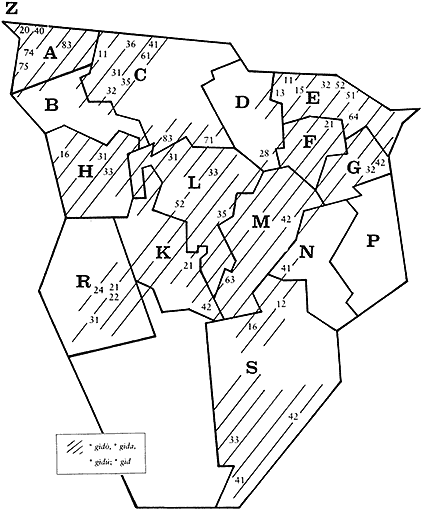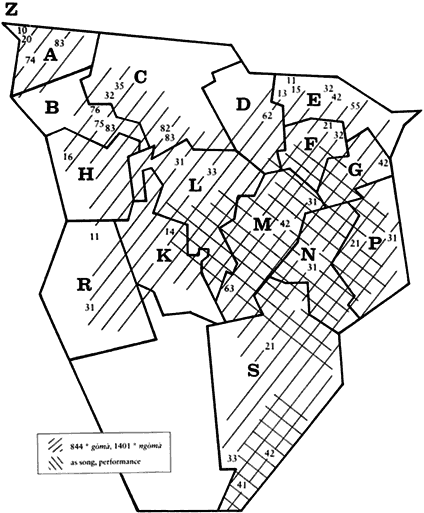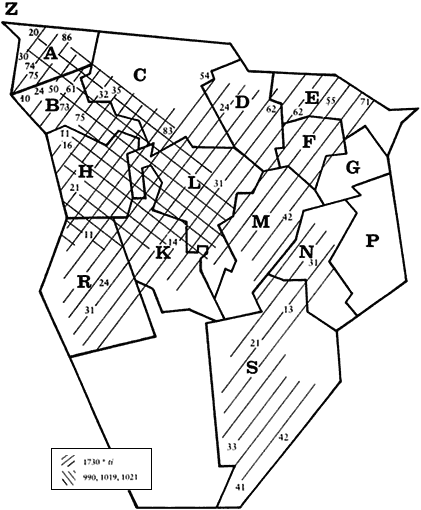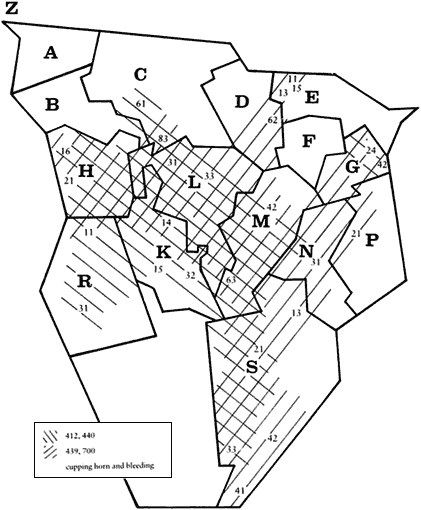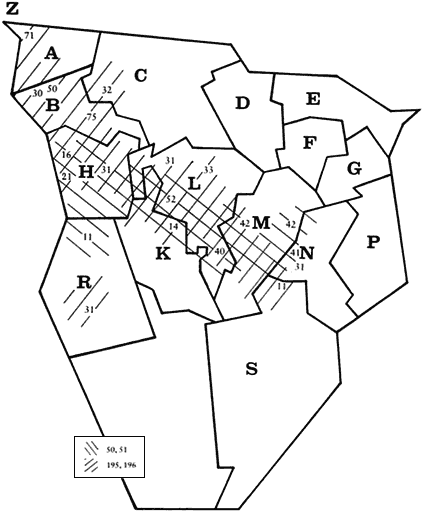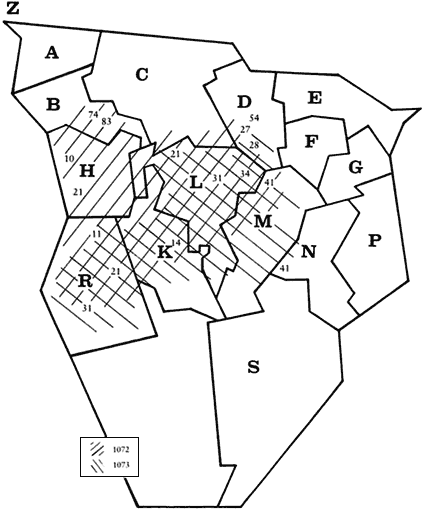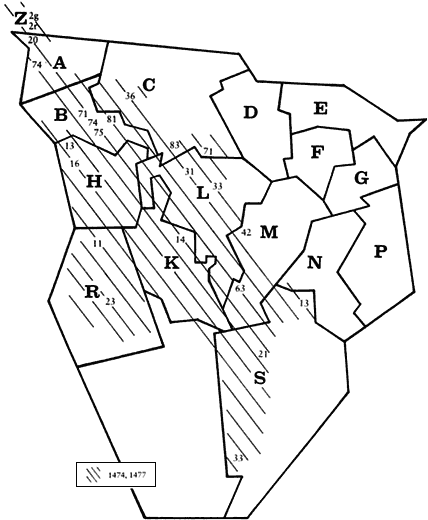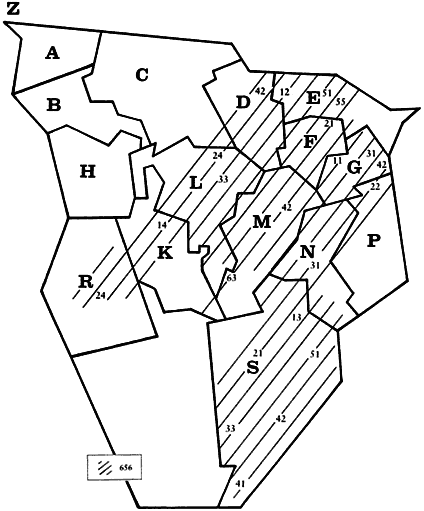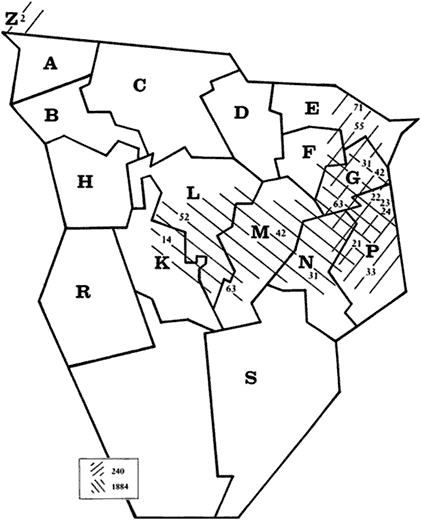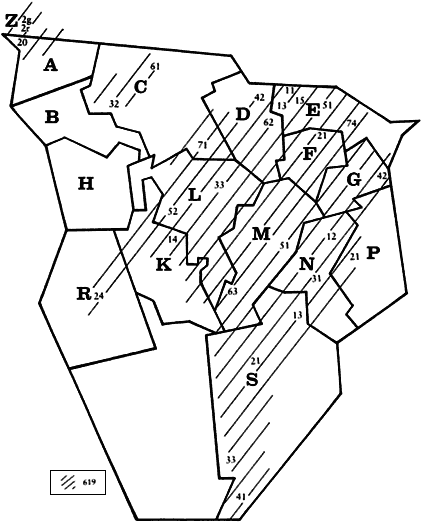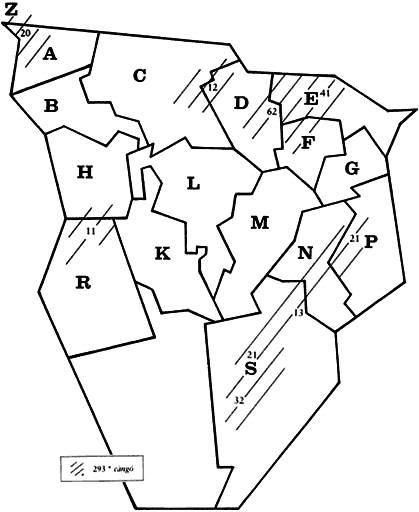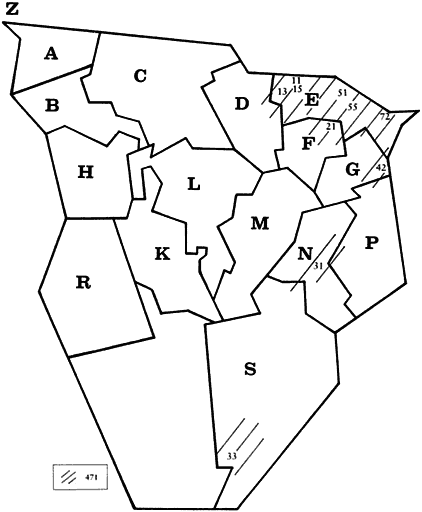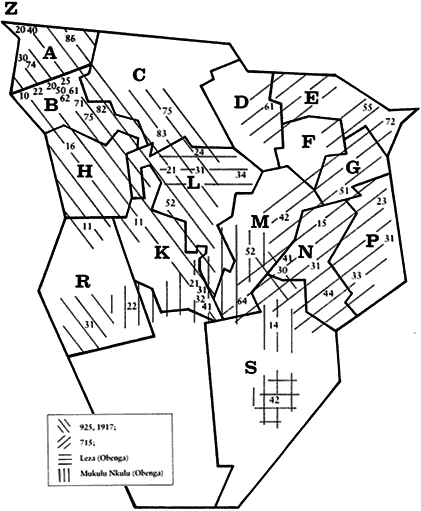Appendix B
Distributions of Terms in Bantu Languages Pertaining to Therapeutic Concepts and Actions
The verbal cognates in these maps are reconstructions of common ancestral terms derived from modern phonetic resemblances and presumed semantic shifts from an original basic sound and meaning. The distributions are based mainly on the work of Malcolm Guthrie, as published in his Comparative Bantu ; the numbers given with most terms are from his Comparative Series (C.S.). Following his convention, the asterisk indicates a reconstructed ancestral or "proto-" form derived from contemporary phonetic and semantic variations. It must be emphasized that these reconstructions are based on a limited number of languages for which glossaries and dictionaries were available in the 1950s and 1960s when Guthrie did his work; thus the distributions shown are approximations and may have gaps. Maps 2, 7, and 19 are based partially on other work.
B.1
C.S. 1608 * -pútá- wound
C.S. 1609 * -púté- wound, boil
This distribution indicates a proto-Bantu cognate, with B.14 coequal in the
Eastern Bantu region.
B.2
C.S. 677 * -dúád- to become ill
C.S. 678 * -dúádì- illness
C.S. 679 * -dúádé- illness
* -gon- to be sick
The cognate -dúád - is distributed so as to suggest an ancient proto-Bantu lexi-
cal item that has been partially replaced by kon or okon in the Western Bantu
forest area (Obenga 1985:196; Huygens 1987:86–93).
B.3
C.S. 644 * -dòg- bewitch, curse
C.S. 645 * -dògá- witchcraft
C.S. 646 * -dògí- witchcraft
C.S. 647 * -dògò- witchcraft
A widespread term in many societies of the subcontinent, an ancient proto-
Bantu and central contemporary concept in therapeutic thought systems.
B.4
C.S. 786 * -gàngà- / * -ngàngà- medicine man, doctor
C.S. 787 * -ganga- medicine
Both healer and medicine are derived from this widespread and presumably
proto-Bantu cognate.
B.5
C.S. 1557 * -píng- curse
C.S. 1558 * -píngö- curse
C.S. 1534 * -píngú- fetish, charm, omen
Guthrie suggests that C.S. 1534 was proto-Bantu and is part of a set including
two synonymous cognates—293 * -càngó -, East Bantu (B.17); and 1072 * -kítì,
West Bantu (B.12)—that emerged where the original item disappeared.
B.6
C.S. 1564 * -pód- to become cold, to cool down
C.S. 1565 * -pód- to become cured, to get well
This bifurcated Western and Eastern Bantu distribution suggests a proto-Bantu
status for this cognate, and the pervasiveness of the notion of "the cool" in
connection with health, purification, or cleansing and by implication, of heat
with sickness, disorder, and pollution.
B.7
C.S. 826 * -gìdò- , -gìda- , -gìdú- substantive form of interdiction, prohibition
C.S. 822 * -gìd- verbal form indicating to interdict, to refuse, to
create an interdiction, to abstain from food, activities, contacts
The reconstruction of this cognate is based primarily on Huygens's recent work
(1987) in the Tervuren Bantu languages project, which is a continuation and
extension of Guthrie's work, as well as his intensive study of the Fang and Beti
languages. Its pervasive distribution suggests it as a part of the proto-Bantu
health conceptual scheme, although there are other terms for this concept.
B.8
C.S. 844 * -gòmà- drum
C.S. 1401 * -ngòmà- drum
Distribution of ngoma as song or performance:
The central cognate of this book, ngoma (drum), is distributed widely through-
out the Bantu language areas, with the exception of the forest regions C and
D. This, and the distribution of the additional meaning of "song" and "perfor-
mance" supports the hypothesis of an Eastern Bantu origin of the therapeutic
ngoma that is the subject of this work.
B.9
C.S. 1730 * -tí- medicine
C.S. 990 * -kàg- to protect with medicine
C.S. 1019 * -káyá- leaf, tobacco
C.S. 1021 * -káyí- leaf
Of these two cognates for plants, or medicinal plants, the more widespread,
-tí-, proto-Bantu, is also identified as "tree" (C.S. 1729) and "stick" (C.S.
1731). The other terms denote medicinal uses of plants or the process of pro-
tecting with medicine, -kàg- . Tobacco, introduced from America, was assimi-
lated to the Western Bantu cognates, -kaya-, -kayi-.
B.10
C.S. 412 * -cúkù - cupping horn
C.S. 440 * -cúmo - cupping horn
C.S. 439 * -cumik - bleed by cupping
C.S. 700 * -dumik - bleed by cupping
Eastern and Western Bantu terms for the cupping horn and for the process of
bleeding by cupping suggest that these are part of an old system of therapy,
although there may have been an even older cognate that is now lost.
B.11
C.S. 50 * -bàndà - ghost
C.S. 51 * -mbàndà - medicine man
C.S. 195 * -búk - to cure
C.S. 196 * -búk - to divine, to cure by divining
There are two related Western Bantu terms for healer, divining, or the process
of healing. Mbanda suggests mediumship in some settings. The distribution of
the term búk suggests an earlier expansion in Western Bantu.
B.12
C.S. 1072 * -kítì - fetish, charm
C.S. 1073 * -kítì -, or -kícì -, spirit
This Western Bantu concept and practice is present as a visible medicine or ob-
ject in its western distribution. At its south and eastern expansion, or frontier,
it comes to be identified mainly as spirit. Its eastern-most occurrence is due to
the expansion of Luba influence in the sixteenth century among the Senga-Sena
linguistic group (Waite 1987).
B. 13
C.S. 1474 * -pémbà - white clay
C.S. 1477 * -pémbé - white clay
The use of white clay or kaolin is pervasive in Sub-Saharan ritual, but this
term for it is Western Bantu. That this cognate is ancient is seen from its
presence among the Tiv of Eastern Nigeria, in the putative origin area of Bantu
languages.
B.14
C.S. 656 * -donda - sore
A common cognate of Eastern Bantu origin.
B.15
C.S. 240 * -cábi - witch, witchcraft
C.S. 1884 * -yábi - ordeal, poison
These two related cognates of Eastern Bantu origin may be related to the Tiv
notion tsav , or tsawi (see Bohannan 1958), the evidence of witchcraft substance
in the bowels of a corpse.
B.16
C.S. 619 * -dímu - spirit
This apparently ancient and proto-Bantu cognate for spirits, usually ancestral,
is widespread in ngoma rituals. Kulu may be the Western Bantu counterpart
for this.
B.17
C.S. 293 * -càngó - fetish, charm
The Eastern Bantu counterpart of -kícì - (B.12), both of which, according to
Guthrie, may have replaced píngö (B.5).
B.18
C.S. 471 * -dagud - practice medicine, divine, foretell
Dagud is the Eastern Bantu counterpart to mbàndà and búk (B.11), which
together supplanted -gàngà - (B.4) in certain instances.
B.19
C.S. 715 * -dungu - Mulungu, Murungu, God
C.S. 925 * -jambé - God
C.S. 1917 * -yambé - or -nyambé - God
* -Leza -, God
* Mukulu, Nkulu, Ancient One, God
These are examples of numerous terms for God used in the attribution of illness
etiologies that contrast to human-caused or spirit-caused etiologies. Obenga
(1985:152–153) is the source for the distribution of the last two terms.
